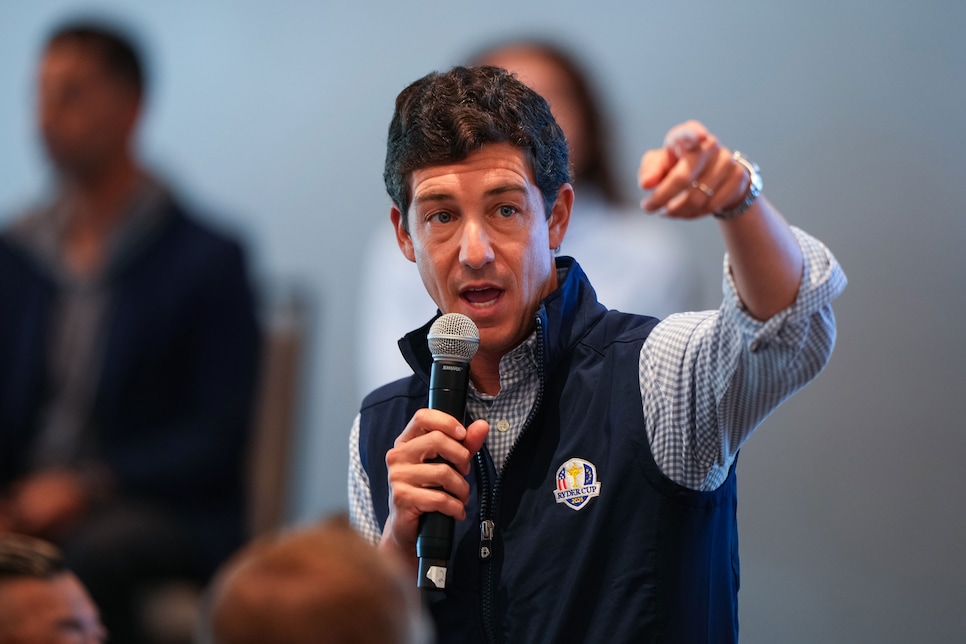[PHOTO: Sam Hodde]
In his office at the PGA of America’s headquarters, Craig Kessler has photos and memorabilia on display that are important to him. There are pictures of his wife, Nicole, and their three boys, ages 5, 8 and 9. There’s a New York City marathon bib number. He and his wife ran this year to raise money for the PGA of America REACH Foundation. And then there’s a frame of a New York Police Department uniform patch. When you see it, you know there’s a story there.
RELATED: New LPGA commissioner finds warm welcome in Texas heat at Women’s PGA Championship
In Kessler’s role as PGA chief operating officer, he loved to celebrate PGA members’ accomplishments. And that special patch belonged to Vincenzo Rallo, who, along with his NYPD partner, rescued several people from a fire in February 2024.
“Any time a PGA of America professional does something noteworthy, I ask our team to tell me about it,” Kessler said. “Rallo is a PGA of America professional nights and weekends, and during the day, he’s a policeman in New York City. He ran into a burning building and saved 11 people, and two of them were babies. I called Vincenzo and I said, ‘I have to meet you. Come to Frisco, my treat. We’ll go play golf and have dinner.’”
Rallo showed up, and Kessler said they had an amazing day together, at the end of which Rallo had a gift. “He said, ‘I know you were inspired by the people I saved when I ran into the burning building. After you called me, I cut out the patch that was on my uniform the night I saved those people. I want you to have it,'” Kessler said.
“To me, it’s a reminder that PGA golf professionals, similar to LPGA golf professionals, they’re more than just golf professionals. They actually make a difference in the communities they serve. This is a constant reminder of that.”

Craig Kessler with Vincenzo Rallo at PGA of America headquarters [Photo: courtesy of Vincenzo Rallo]; Rallo’s NYPD patch (inset) [Photo: courtesy of LPGA]
• • •
By all accounts, Craig Kessler is a people person. And it’s that trait the LPGA hopes to benefit from – along with his vision, golf connections and business savvy – as the 40-year-old officially takes over today as the 10th LPGA commissioner.
It comes at a time when the LPGA has an opportunity to ride a wave of momentum in women’s sports. Leagues like the NWSL and WNBA and even NCAA women’s sports have capitalised on the movement, guided by megastars like Caitlin Clark. Salaries, endorsement and NIL deals have jaw-dropping price tags, and arenas are sometimes selling out. To date, the LPGA has lagged behind in these efforts, the need, along with the opportunity, to catapult its biggest stars into becoming household names coming to an inflection point at this moment. Fans and critics of the tour both say it has to find a way to show off its talented players, and create must-watch TV, like what happened when world No.1 Nelly Korda was on her historic run of five consecutive wins last year.
RELATED: Australian WPGA Championship and Festival of Golf to return to the Gold Coast in 2026
Kessler says his to-do list – as he changes work locations from PGA of America headquarters to a home office in Dallas – at first won’t be a never-ending sheet of dozens and dozens of items. Rather, in the first few weeks on the job he intends to identify a few critical areas to focus in which he believes he can make an immediate impact.
“Our job as a leadership team at the LPGA is going to be to sift through what’s possible and pick a couple of things that we’re going to go after, because no organisation can take on too much and be successful,” Kessler said. “We’re going to have to ruthlessly prioritise… The first thing we’re going to tackle as a team is figuring out what bets to place.”
As Kessler works to build that priority list, Golf Digest talked to various tour players and officials to see what they would advise him to consider. Among the things discussed were that LPGA tournament broadcasts currently are a jumbled mixture of streaming and linear network coverage, whether that’s NBC, Peacock, Golf Channel, ESPN+ and CBS. A consistent presence with more cameras on more players is needed. Then there’s the purses; while LPGA players are playing for more money than ever, there is inconsistency between tournaments, creating a tiered event structure along with a tiered hierarchy among players.
Providing stability is something many mentioned as well. Kessler is the third commissioner in five years, after the short and controversial tenure of Mollie Marcoux Samaan. While Liz Moore, served admirably in the interim role as the LPGA began the celebration of its 75th anniversary, having somebody who can ease player concerns regarding the future is critical if only for morale.
Before jumping in, Kessler, who previously was the chief operating officer of Topgolf, has been working to build trust among the LPGA key stakeholders. “It starts with players, our sponsors, our team, the media,” Kessler said. “I mean it when I say there’s massive opportunity in front of us, but there is no silver bullet in order to exploit that opportunity. This is going to require a massive team effort and all the stakeholders I just mentioned are going to play a role or roles in bringing that opportunity to life. In order to get there, trust is at the root of everything we’re going to do.”
Maja Stark, the US Women’s Open champion and the eighth-ranked player in the world, thinks television coverage must be Kessler’s priority.
“We need more exposure. We hear all the time the broadcasts aren’t good,” Stark said. “As a person who loves to watch golf herself, broadcasting is a big thing, having more cameras out there, getting some better TV windows. I have no idea how that works, but I think that should be a top priority.”
Kessler knows this is an issue because he’s been watching, too. He usually goes on an early morning run followed by meetings that often begin at 6am. In addition to getting a jump on the workday, he makes time for his sons and their activities, which is why his phone calls with PGA of America chief executive Derek Sprague could often come before 7am or at 10pm.
“He’s always looking for solutions and ways to do things differently, which I think is great,” Sprague said. “Golf organisations seem to be steeped in tradition, and he’ll bring a breath of fresh air to the LPGA, thinking differently, to use a cliché. He thinks outside the box, in non-traditional ways. He’ll bring some of those great ideas as well as looking at the game a little differently to bring more eyeballs to the LPGA and to women in golf. So I think it’ll be a great fit.”
Among Kessler’s top qualities, Sprague says, is his penchant for posing questions and being dogged in finding the answers. “He’s not afraid to call people he doesn’t even know, but who may have the answer,” Sprague said. “And I think that’s important versus going in, and thinking he has all the answers, which he knows he doesn’t. That’s a great humble quality to have as a good leader.”
Sprague and Kessler – a 5.5 handicapper – also play golf together, and Kessler, who’s a foodie, would sometimes have a hot dog at the turn. Kessler has a slender frame, and while he’s no Joey Chestnut, Sprague has had memorable meals with him.
“It’s amazing how much food this guy can put away,” Sprague laughed. “I always ask him if has a hollow leg or what. The energy that he has, and he has a high metabolism. It’s incredible.”
Even though they’ll be working for different organisations now, they plan to hold monthly check-in calls and challenge each other to make their organisations better.
“We’re going to work on elevating the women’s game,” Sprague said. “We have thousands of women that are PGA professionals who teach. We have [more than] 1,000 LPGA professionals in our organisation. It’s important for us at the PGA of America to elevate the women’s game and with him going there, I think we can do more together than separately. That’s sort of one of the maybe comforting parts for both of us, not only him, but me too, where I can reach out to him and we can continue to bounce ideas off.”
• • •
Kessler went to college at Georgetown University and earned an MBA from Harvard Business School. Asked the most important thing he learned at Harvard that he uses to be successful in business and the answers were simple.
“There are a couple things. One, people first. If you can build relationships that are rooted in authenticity and trust, it opens up a world of possibilities,” Kessler said.
“Two, and this may sound surprising, but vulnerability, in my opinion, is a powerful thing. There are a lot of leaders who think they have to have all the answers and put on a tough face. I think the opposite is totally true. The willingness to admit you don’t know something and the willingness to be really vulnerable to ask for help is attractive and will encourage others to maybe step up and help in areas where maybe they may know more than the new leader does.”

Among Kessler’s best traits, according to those who know him, is a willingness to listen and rely on others to help him answer questions rather than think he know them all himself. [Photo: Darren Carroll/PGA of America]
Kessler was doing exactly that last month at the KPMG Women’s PGA Championship, taking advantage of the LPGA coming to the home of the PGA of America in late June. Kessler used the tournament as an unofficial start to his commissionership, working the range, putting green, dining and wherever he could find players to introduce himself and talk.
The weather that week was unpleasant, temperatures near 100 degrees Fahrenheit (38 Celsius) and high humidity. Kessler could’ve summoned players to his air-conditioned office at the main headquarters, which wasn’t far from the driving range. That’s not his style.
Wearing a long-sleeved button-downed shirt and blazer during a practice round day, Kessler did a live television interview on set outside. Afterwards, he toted around the jacket along and a water bottle. He heard Angel Yin, a perennially US Solheim Cup team member and the seventh-ranked player in the world, had done an interview about him without having met him yet. He wanted to make sure to meet one of the tour’s most personable players and found out she was on the range. When Yin was told through an LPGA spokesperson that he wanted to come meet her, she said there was no way he was going to go all the way to the range to meet her. Within five minutes, he was on a golf cart and on the range having a conversation with Yin. She was surprised.
“I actually think we’re doing pretty good, to be honest,” Yin said. “Our purses are going up. We have a lot of new events, new experiences, places to go to spread women’s golf and inspire the next generation of female golfers. There’s not much I can complain about. In any organisation, you always try to be better and ask, ‘Where can we better?’”

Kessler spent time talking to LPGA players, including Angel Yin, during last month’s KPMG Women’s PGA Championship in Frisco, Texas. [Photo: Sam Hodde]
During the news conference that introduced his hiring in May, Kessler identified four pillars that will guide him as the LPGA’s new commissioner: building trust, making the tour’s stars visible, building the LPGA fan base and building a financial future for the tour. He plans to run the LPGA like he would any business, and he believes these pillars work with all organisations.
Kessler has also had talks with Angela Stanford, the recently retired seven-time LPGA winner who will be the US Solheim Cup captain in 2026 when the matches go to the Netherlands. Stanford believes TV and analytics should be priorities for Kessler and the LPGA. Stanford is doing on-course reporting for ESPN+, which gives her a unique perspective.
“Analytics matter,” Stanford said. “I told [Kessler] that I worked TV for the men’s events and women’s events, and that the men have every number you could ever imagine, and you can tell their story very specifically and where they fit on tour and why they’re so good. That is extremely important.
“Our next little step up and the next little part of building this house has to be that we have to show people specifically why we’re so great. I’ve been saying for 25 years that the women are so much better than people know. There’s no way to prove it. There’s no data. You can’t see it on your television. The few events I’ve seen that use ShotLink, have you seen how straight the line is? That, and in combination with television, we have to figure out our TV. What makes sense for us? When to stream and how do we grow that?”
The other thing for Stanford is purses. The good news for the LPGA is that the overall prizemoney payout on tour is a record $US132.6 million, an increase of $US62 million over the past four years. That’s a 90 percent increase since 2021. However, much of that comes from majors and the CME Group Tour Championship, which have high seven-figure and low eight-figure paydays. And while some regular stops on tour are competitive as well, there are 16 events that have a purse of $US2.5 million or less.
KPMG announced the week of the Women’s PGA that it was raising its purse to $US12 million, tying the US Women’s Open for the highest payout in history. With a winner’s payout of $US2.4 million, Stark made more than the entire purse of many events, which isn’t a way to attract the game’s biggest stars or fans.
“I think the majors and CME are doing their part,” Stanford said. “We need everybody else to do their part. Can they commit to raising their purse the next five years?”
• • •
Alison Curdt, a PGA and LPGA master professional, qualified and played in the KPMG Women’s PGA, her eighth appearance in the major. The director of instruction at Wood Ranch Golf Club in Simi Valley, California, first talked to Kessler when he began with the PGA of America, and he reached out to section executive directors and attended meetings. At a local PGA section meeting, Kessler asked questions about Curdt’s research on athletic trauma and her other gig as a licensed sports psychotherapist. Kessler mentioned he liked to read on flights and had a book recommendation for her, Thinking, Fast and Slow. He then asked where he could learn more about her research. Curdt recommended The Body Keeps the Score: Brain Mind & Body in Healing of Trauma. That started their own mini book club of sorts.
“Every time we saw each other, we had that personal connection and he would recognise that, recognise me by name,” said Curdt, who is among Golf Digest’s 50 best teachers in America. “He reached out to me before KPMG, and asked if there was anything I needed before the event and how I was feeling, and he had actually done that to all the club professionals. And that was a really special gesture to reach out to us prior to heading to that event. On property, he sought us out at a party, and conversed with us.”
They texted their thoughts on what they learned from the books. When Curdt knew the LPGA was looking for a new commissioner, she reached out to tell Kessler he would be perfect for the role and should apply.
He got the job and he’ll try to use all those skills – networking, listening, talking, golfing – that he has to improve the LPGA in this next era.
No doubt he’ll be bringing that patch as a reminder of all those continuing to make a difference in their communities.




